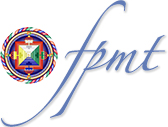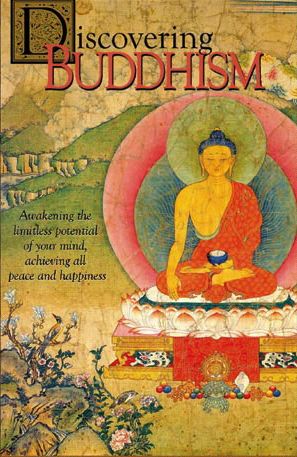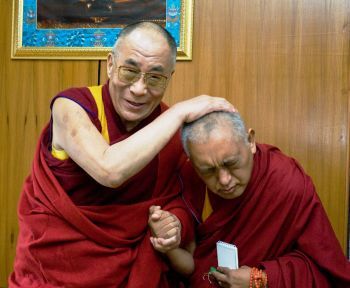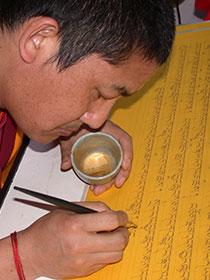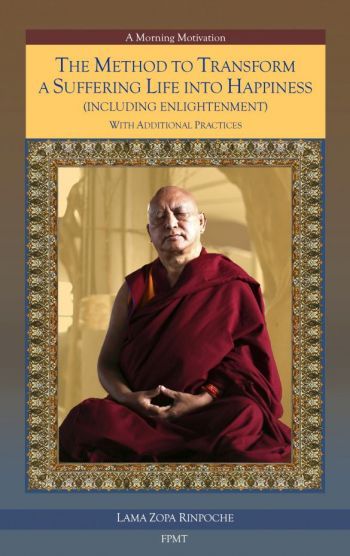- Home
- FPMT Homepage
Foundation for the Preservation of the Mahayana Tradition
The FPMT is an organization devoted to preserving and spreading Mahayana Buddhism worldwide by creating opportunities to listen, reflect, meditate, practice and actualize the unmistaken teachings of the Buddha and based on that experience spreading the Dharma to sentient beings. We provide integrated education through which people’s minds and hearts can be transformed into their highest potential for the benefit of others, inspired by an attitude of universal responsibility and service. We are committed to creating harmonious environments and helping all beings develop their full potential of infinite wisdom and compassion. Our organization is based on the Buddhist tradition of Lama Tsongkhapa of Tibet as taught to us by our founders Lama Thubten Yeshe and Lama Thubten Zopa Rinpoche.
- Willkommen
Die Stiftung zur Erhaltung der Mahayana Tradition (FPMT) ist eine Organisation, die sich weltweit für die Erhaltung und Verbreitung des Mahayana-Buddhismus einsetzt, indem sie Möglichkeiten schafft, den makellosen Lehren des Buddha zuzuhören, über sie zur reflektieren und zu meditieren und auf der Grundlage dieser Erfahrung das Dharma unter den Lebewesen zu verbreiten.
Wir bieten integrierte Schulungswege an, durch denen der Geist und das Herz der Menschen in ihr höchstes Potential verwandelt werden zum Wohl der anderen – inspiriert durch eine Haltung der universellen Verantwortung und dem Wunsch zu dienen. Wir haben uns verpflichtet, harmonische Umgebungen zu schaffen und allen Wesen zu helfen, ihr volles Potenzial unendlicher Weisheit und grenzenlosen Mitgefühls zu verwirklichen.
Unsere Organisation basiert auf der buddhistischen Tradition von Lama Tsongkhapa von Tibet, so wie sie uns von unseren Gründern Lama Thubten Yeshe und Lama Thubten Zopa Rinpoche gelehrt wird.
- Bienvenidos
La Fundación para la preservación de la tradición Mahayana (FPMT) es una organización que se dedica a preservar y difundir el budismo Mahayana en todo el mundo, creando oportunidades para escuchar, reflexionar, meditar, practicar y actualizar las enseñanzas inconfundibles de Buda y en base a esa experiencia difundir el Dharma a los seres.
Proporcionamos una educación integrada a través de la cual las mentes y los corazones de las personas se pueden transformar en su mayor potencial para el beneficio de los demás, inspirados por una actitud de responsabilidad y servicio universales. Estamos comprometidos a crear ambientes armoniosos y ayudar a todos los seres a desarrollar todo su potencial de infinita sabiduría y compasión.
Nuestra organización se basa en la tradición budista de Lama Tsongkhapa del Tíbet como nos lo enseñaron nuestros fundadores Lama Thubten Yeshe y Lama Zopa Rinpoche.
A continuación puede ver una lista de los centros y sus páginas web en su lengua preferida.
- Bienvenue
L’organisation de la FPMT a pour vocation la préservation et la diffusion du bouddhisme du mahayana dans le monde entier. Elle offre l’opportunité d’écouter, de réfléchir, de méditer, de pratiquer et de réaliser les enseignements excellents du Bouddha, pour ensuite transmettre le Dharma à tous les êtres. Nous proposons une formation intégrée grâce à laquelle le cœur et l’esprit de chacun peuvent accomplir leur potentiel le plus élevé pour le bien d’autrui, inspirés par le sens du service et une responsabilité universelle. Nous nous engageons à créer un environnement harmonieux et à aider tous les êtres à épanouir leur potentiel illimité de compassion et de sagesse. Notre organisation s’appuie sur la tradition guéloukpa de Lama Tsongkhapa du Tibet, telle qu’elle a été enseignée par nos fondateurs Lama Thoubtèn Yéshé et Lama Zopa Rinpoché.
Visitez le site de notre Editions Mahayana pour les traductions, conseils et nouvelles du Bureau international en français.
Voici une liste de centres et de leurs sites dans votre langue préférée
- Benvenuto
L’FPMT è un organizzazione il cui scopo è preservare e diffondere il Buddhismo Mahayana nel mondo, creando occasioni di ascolto, riflessione, meditazione e pratica dei perfetti insegnamenti del Buddha, al fine di attualizzare e diffondere il Dharma fra tutti gli esseri senzienti.
Offriamo un’educazione integrata, che può trasformare la mente e i cuori delle persone nel loro massimo potenziale, per il beneficio di tutti gli esseri, ispirati da un’attitudine di responsabilità universale e di servizio.
Il nostro obiettivo è quello di creare contesti armoniosi e aiutare tutti gli esseri a sviluppare in modo completo le proprie potenzialità di infinita saggezza e compassione.
La nostra organizzazione si basa sulla tradizione buddhista di Lama Tsongkhapa del Tibet, così come ci è stata insegnata dai nostri fondatori Lama Thubten Yeshe e Lama Zopa Rinpoche.
Di seguito potete trovare un elenco dei centri e dei loro siti nella lingua da voi prescelta.
- 欢迎 / 歡迎
简体中文
“护持大乘法脉基金会”( 英文简称:FPMT。全名:Foundation for the Preservation of the Mahayana Tradition) 是一个致力于护持和弘扬大乘佛法的国际佛教组织。我们提供听闻,思维,禅修,修行和实证佛陀无误教法的机会,以便让一切众生都能够享受佛法的指引和滋润。
我们全力创造和谐融洽的环境, 为人们提供解行并重的完整佛法教育,以便启发内在的环宇悲心及责任心,并开发内心所蕴藏的巨大潜能 — 无限的智慧与悲心 — 以便利益和服务一切有情。
FPMT的创办人是图腾耶喜喇嘛和喇嘛梭巴仁波切。我们所修习的是由两位上师所教导的,西藏喀巴大师的佛法传承。
繁體中文
護持大乘法脈基金會”( 英文簡稱:FPMT。全名:Found
ation for the Preservation of the Mahayana Tradition ) 是一個致力於護持和弘揚大乘佛法的國際佛教組織。我們提供聽聞, 思維,禪修,修行和實證佛陀無誤教法的機會,以便讓一切眾生都能 夠享受佛法的指引和滋潤。 我們全力創造和諧融洽的環境,
為人們提供解行並重的完整佛法教育,以便啟發內在的環宇悲心及責 任心,並開發內心所蘊藏的巨大潛能 — 無限的智慧與悲心 – – 以便利益和服務一切有情。 FPMT的創辦人是圖騰耶喜喇嘛和喇嘛梭巴仁波切。
我們所修習的是由兩位上師所教導的,西藏喀巴大師的佛法傳承。 察看道场信息:
- FPMT Homepage
- News/Media
-
- Study & Practice
-
-
- About FPMT Education Services
- Latest News
- Programs
- New to Buddhism?
- Buddhist Mind Science: Activating Your Potential
- Heart Advice for Death and Dying
- Discovering Buddhism
- Living in the Path
- Exploring Buddhism
- FPMT Basic Program
- FPMT Masters Program
- FPMT In-Depth Meditation Training
- Maitripa College
- Lotsawa Rinchen Zangpo Translator Program
- Universal Education for Compassion & Wisdom
- Online Learning Center
-
- Prayers & Practice Materials
- Overview of Prayers & Practices
- Full Catalogue of Prayers & Practice Materials
- Explore Popular Topics
- Benefiting Animals
- Chenrezig Resources
- Death & Dying Resources
- Lama Chopa (Guru Puja)
- Lama Zopa Rinpoche: Compendium of Precious Instructions
- Lama Zopa Rinpoche: Life Practice Advice
- Lama Zopa Rinpoche Practice Series
- Lamrim Resources
- Mantras
- Prayer Book Updates
- Purification Practices
- Sutras
- Thought Transformation (Lojong)
- Audio Materials
- Dharma Dates - Tibetan Calendar
- Translation Services
- Publishing Services
- Ways to Offer Support
- Prayers & Practice Materials
-
- Teachings and Advice
- Find Teachings and Advice
- Lama Zopa Rinpoche Advice Page
- Lama Zopa Rinpoche: Compendium of Precious Instructions
- Lama Zopa Rinpoche Video Teachings
- ༧སྐྱབས་རྗེ་བཟོད་པ་རིན་པོ་ཆེ་མཆོག་ནས་སྩལ་བའི་བཀའ་སློབ་བརྙན་འཕྲིན།
- Podcasts
- Lama Yeshe Wisdom Archive
- Buddhism FAQ
- Dharma for Young People
- Resources on Holy Objects
- Teachings and Advice
-
-
*If a menu item has a submenu clicking once will expand the menu clicking twice will open the page.
-
-
- Centers
-
- Teachers
-
- Projects
-
-
-
-
*If a menu item has a submenu clicking once will expand the menu clicking twice will open the page.
-
-
- FPMT
-
-
-
-
-
Our grabbing ego made this body manifest, come out. However, instead of looking at it negatively, we should regard it as precious. We know that our body is complicated, but from the Dharma point of view, instead of putting ourselves down with self-pity, we should appreciate and take advantage of it. We should use it in a good way.
Lama Thubten Yeshe
-
-
-
- Shop
-
-
-
The Foundation Store is FPMT’s online shop and features a vast selection of Buddhist study and practice materials written or recommended by our lineage gurus. These items include homestudy programs, prayers and practices in PDF or eBook format, materials for children, and other resources to support practitioners.
Items displayed in the shop are made available for Dharma practice and educational purposes, and never for the purpose of profiting from their sale. Please read FPMT Foundation Store Policy Regarding Dharma Items for more information.
-
-
Lama Yeshe’s Wisdom
10
Beginning to Understand Karma
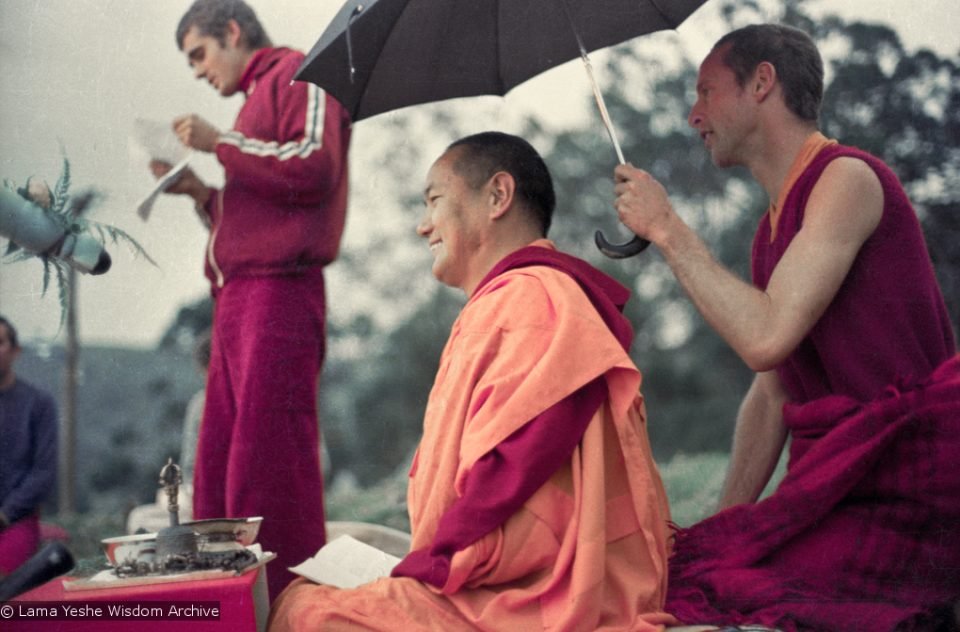
Lama Yeshe doing a fire puja while Jhampa Zangpo (Mark Shaneman) holds an umbrella, Chenrezig Institute, Australia, 1976. Photo courtesy of Lama Yeshe Wisdom Archive.
Lama Thubten Yeshe, who founded the FPMT organization with Lama Zopa Rinpoche, is fondly remembered for his ability to communicate the essence of Buddhist teachings in a way that continues to connect with Western students. In the following excerpt, Lama Yeshe discusses karma:
There’s not just one, fixed, mathematical way of explaining karma; there are many different ways, including the subheading and numbered list approach. Sometimes it seems that people new to Buddhism find karma hard to understand, but actually, it’s easy to get a rough, initial understanding of it.
Of course, once you get into the details, karma can be extraordinarily complex, too, but when I introduce it to beginners, I try to keep it simple so that they can get at least a basic, intellectual understanding. In reality, the only way you can get a total understanding of karma is through your own experience, and that experience is beyond words.
Trying to get a total understanding of karma through the intellect alone is like trying to count every atom of earth, water, fire, and air in the universe, which is impossible,
Fundamentally, what is karma? Karma is your body, speech, and mind. That’s it. It’s very simple. If I were to try to compare the subject of karma to the kinds of things you study in the West, I’d say that it parallels in some ways the theory of the evolution of everything that exists. Karma encompasses everything on Earth and beyond, every existent phenomenon in the universe, throughout infinite space—in Buddhist terms, every phenomenon in samsara and nirvana. Karma is the energy of all phenomena and has nothing to do with what your mind believes.
If karma encompasses all relative phenomena, are these phenomena interconnected? Well, even modern science understands that all the energy in the universe is interdependently related; it’s not just Buddhist dogma.
For example, where does all the green vegetation we see around us come from? It doesn’t arise without cause. First there has to be a cause; then, the effect—the relative appearance of the green—arises. Similarly, each of us also has a cause; we, too, are interdependent phenomena. We depend on other energies for our existence. Those energies, in turn, depend on yet other energies. In this way, all energy is linked.
You probably think your body comes from the supermarket: as long as the supermarket’s there, you can eat; as long as you can eat, you exist. Obviously, it goes much deeper than that. Therefore, your conception of what you are—“I am. I’m this; I’m that; I’m this”—is like a dream. Intuitively, your ego has this notion that you’re independent, that you’re not a dependent phenomenon. That’s complete rubbish.
If you look, you can easily see how you’re interdependent. It looks complicated; it’s not complicated. It only becomes complicated if your mind thinks it’s complicated. Your mind makes things up; that’s karma, too—an interdependent phenomenon; it exists in relation to other energy. If you understand the basic simplicity of this, you’ll be more careful in the way you act because you’ll realize that every single action of your body, speech, and mind produces a reaction.
We describe samsara as cyclic: it’s like a wheel, it goes round; one thing produces another, that produces another, and so it goes on, one thing pushing the other. And each karmic action is like the seed that produces a flower that in turn produces hundreds of seeds, which then result in hundreds more flowers that produce hundreds more seeds each. In this way, in a relatively short time, one seed produces thousands and thousands of results.
The actions of your body, speech, and mind are the same. Each action, positive or negative, good or bad, produces an appropriate result.
Also, karma doesn’t depend on your believing in it or not. The mere fact of your existence proves the existence of karma. Irrespective of whether you want to know about karma or not, whether you believe in it or not, it doesn’t matter: you are karma. Whether you accept karma or reject it, you can’t separate yourself from karma any more than you can separate yourself from energy. You are energy; you are karma. If you’re a human being, it doesn’t matter whether others think you’re a human being or not—you’re a human being. It doesn’t depend on what you think, either. The truth of all existence doesn’t depend on what people believe.
Sometimes you might think, “OK, Buddhists accept karma. They try to do good, avoid evil, and perhaps enjoy positive results, but what about people who don’t believe in karma?”
But whether you believe or not, your suffering and problems have a cause. They don’t depend on what you believe. Do you think you suffer only because you think you suffer? No. Even if you say, “I’m not suffering,” you’re suffering. Suffering comes along with your very life.
Therefore, I often say that the Buddhist connotation of religion is a little different from the Western one. But when I say that, I’m not saying Buddhism is better; it’s just different. Its analytical approach is different.
Excerpted from “Beginning to Understand Karma” a teaching given by Lama Yeshe at Chenrezig Institute, Queensland, Australia, on June 28, 1976. Edited by Nicholas Ribush for the Lama Yeshe Wisdom Archive (LamaYeshe.com). Also excerpted in Mandala, February-March 2004.
Through timely advice, news stories, and updates, FPMT.org and Mandala Publications share the wisdom culture inspired and guided by the teachings of FPMT founders, Lama Thubten Yeshe and Lama Thubten Zopa Rinpoche.
26
Appearance and Illusion
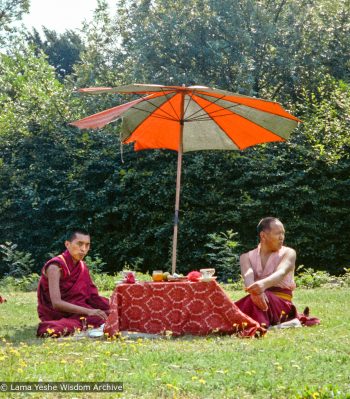
Lama Zopa Rinpoche and Lama Yeshe, Manjushri Institute, England, 1977. Photo by Dennis Heslop, courtesy Lama Yeshe Wisdom Archive.
Lama Thubten Yeshe, who founded the FPMT organization with Lama Zopa Rinpoche, is fondly remembered for his ability to communicate the essence of Buddhist teachings in a way that continues to connect with Western students. In 1977, Lama Yeshe offered teachings at Manjushri Institute in England, where he talked about the reality of how things exist. Here’s a short excerpt from this teaching:
Why do we say that the phenomena of the sense world appear to us as illusory? An illusion is something that does not exist in the way it appears; it’s not real. It’s a false vision; it gives us a false impression. It is misleading to believe in and follow it. Similarly, if we don’t see the objects of the sense world as illusions, in fact, if we believe the opposite, that these phenomena are real, dualistic, concrete entities, we are misled.
Why are all these relative conceptions, movements, and energies illusory? Because in appearance they seem to be real, whereas in reality, they are something else. The universal reality of all relative existence is something else; therefore, it is like an illusion.
Saying that relative existence is like an illusion is not just some philosophical fabrication. Nor does it mean that you lose your sense of proportion or your ability to discriminate and that everything gets all mixed up, like soup. It means that you see the phenomena of the sense world as an illusory bubble, simultaneously recognizing that these dualistic manifestations are actually non-dual in nature; they are born from the space of insubstantial non-self-existence and disappear back into it.
What is the psychological effect of seeing all this as an illusion? This wisdom is the antidote, or the solution, to the extreme mind. For example, in the morning, for some reason, you might be extremely happy. Some bubble of excitement appears, you perceive and believe it and think, “Oh, fantastic! I’m happy.” You feel incredibly overestimated happiness. By receiving the relative bubble hallucinated vision of perhaps one chocolate from some bubble man or woman, you feel an incredible, extreme explosion of happiness. In the terminology of Buddhism, such extreme happiness is negative. It’s too uncontrolled. Its nature, its function, its effect is to bring you down. So, in the morning, some bubble like that appears, and you’re interested. In the afternoon, nothing happens, so you’re bored. Your mind comes down; further and further down.
All our dealings with the relative world, all our up and down, being happy, unhappy, happy, unhappy, happy, unhappy, all these extreme feelings come from mistaken, dualistic perception, from holding ecstatic, happy objects and miserable, unhappy objects as concrete, self-existent, dualistic self-entities.
Beauty exists. I’m not saying that we have to reject beauty. What should concern us, however, is the way our projection of concreteness, independence, and self-existence onto the relative bubble of transience, dependence, and non-self-existent overpowers, overwhelms, and dominates our entire reality.
How do you perceive that object of happiness or that object of misery? If you see it as illusory and non-dual, extreme feelings that pump you up so that there’s no space for other feelings cannot function. You have no unequal, unbalanced energy.
If we can recognize the unity of the absolute reality of these two extreme objects, if we can see how these objects are in reality equal in nature—and also in nature with ourselves, the subject—our lives will be balanced.
This teaching is an excerpt from A Commentary on the Yoga Method of Divine Wisdom Manjushri, given at Manjushri Institute, Cumbria, England, in August, 1977; edited by Nicholas Ribush, published in the Lama Yeshe Wisdom Archive E-letter, January 2014. Read more from this teaching in Mandala, April-June 2009.
Through timely advice, news stories, and updates, FPMT.org and Mandala Publications share the wisdom culture inspired and guided by the teachings of FPMT founders Lama Thubten Yeshe and Lama Thubten Zopa Rinpoche.
17
Meditation on the Clarity of Mind
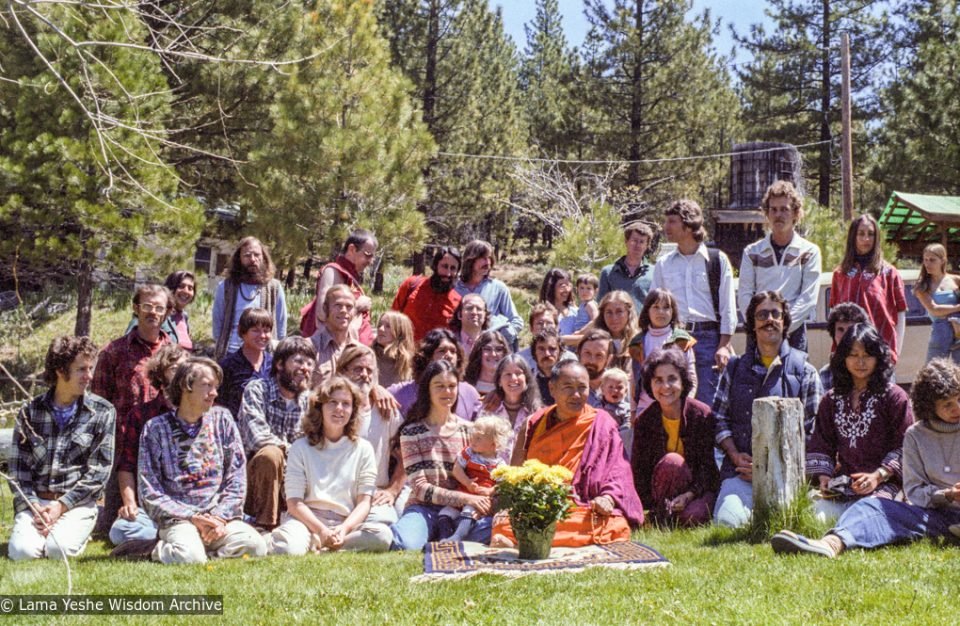
Lama Yeshe with retreat group at Grizzly Lodge, California, US, 1980. Photo courtesy of Lama Yeshe Wisdom Archive.
Lama Thubten Yeshe, who founded the FPMT organization with Lama Zopa Rinpoche, is fondly remembered for his ability to communicate the essence of Buddhist teachings in a way that continues to connect with Western students. In 1980, Lama Yeshe offered teachings on the yoga method of Chenrezig at Grizzly Lodge, California, US. Here’s an excerpt from these teachings, in which Lama Yeshe offers instruction on meditation:
What is meditation? Meditation is simple. It means maintaining memory of the object you’re focused on; here, the clean clear nature of mind. It means keeping your focus on one object without spinning or reacting.
For example, when you’re filming something, first you check that your object is in focus and once it is, you let go. That’s a good example. First you set your mind on the object and once it’s clear, let go. The camera person’s goal is to maintain focus. That’s meditation.
At the same time, you comprehend, or are aware of, what reflections enter the mirror of your clean clear consciousness. Remain aware, but don’t react to what appears; don’t engage it in conversation, “Hello, how are you again?” Just be aware, don’t converse, because when you start a that-this conversation, superstition arises.
Another example is when you and a friend are walking down a track. Part of you is watching the ground to make sure you don’t trip over anything; at the same time you’re chatting with your friend, “Blah, blah, blah.” That’s why the human mind is powerful; that’s why human beings are buddha. Yes; as a matter of fact, buddha is within you. We can do two things at the same time and comprehend both simultaneously.
Also, the way you should develop comprehension is without forgetting your focus. You’re walking continuously and at the same time talking. Similarly, in meditation, you keep your mind focused on the object of concentration and at the same time, without shifting from there, your comprehension, or awareness, functions as a spy, watching what’s going on without reacting. The perfect spy watches without reacting.
Another thing to remember is to let go and not be greedy: “I want more; I want more.” That’s no good. Stay away from that. When you want more you start exerting unnecessary effort. That’s a hindrance to good meditation. Be careful.
So, being a meditator isn’t an easy job. How much effort should you exert and when? Take the middle way. Too much effort makes you tense. When you get tense you get tired. Then the quality of your meditation deteriorates. That’s its nature. So be reasonable. It’s like human relationships. When there’s tension between a couple they start grabbing at each other and when that happens you know they’re going to crash. You can see. Meditation is similar; so you have to be very skillful in the way you apply effort.
The other thing you need skill in is applying the antidotes to sluggishness. There are two forms of sluggishness, gross and subtle. It would take too much time to go into detail here but I just want to warn you to look out for it. When you’re contemplating the clean clear nature of your own thought and a slight impression of darkness enters your mind, that’s a sign that sluggishness is arising.
It’s a bit like when you’re outside in the sun and a light cloud quietly moves over the sun making your surroundings a little less bright. So watch the brightness of your meditation and if it starts to dull, put in a little effort to clear it up. But don’t then keep trying to make it clearer, clearer, clearer with more and more effort. If you do you’ll just get totally distracted again. So be careful.
When you’re contemplating the clarity of your thought you can get an experience that your body no longer exists, or perhaps you can see your subtle body in such great detail that feel you could count the number of atoms in your body. Such things happen. Another point you might reach is where you feel you could count all the atoms in the universe; or perhaps there are none—everything has disappeared. No matter what you experience, don’t react; don’t make conversation. Just be aware but do not shift from the main point of your meditation; comprehend what’s happening but keep going.
When you bring your meditation to an end you might feel as if you’re a new being that has come from space, that your body is also new. I’m not talking about what’s actually happened—just the way you feel, what you might experience.
This kind of meditation can also help you overcome negative feelings about your body; that it’s sort of old and damaged and kind of heavy. If you think of your body that way then that’s how it will appear. Instead, you should recognize it for the valuable, precious mechanism that it is.
We’ve all had that experience. Sometimes, for no apparent reason—you’re eating well, sleeping well—you always feel tired, heavy. This means that somewhere within you’ve decided you’re heavy. Your mind has decided you’re heavy, so you feel heavy. You can overcome that by applying the antidote—decide you’re light, run a bit and perhaps that heavy feeling will disappear. It can happen; sometimes the mind is very strange.
When you do this meditation well and have a really clean clear experience, especially if you develop deep focus on the clarity of our consciousness, you will feel much bliss and joy because your superstition, ego conflict and dissatisfaction have dropped out. When they’re absent, bliss automatically arises.
But to get there you have to start small and deep. Small and deep is much better than pushing for a sudden explosion of energy. That coupled with a lack of wisdom leads to further uncontrolled samsaric trips. So, start deep and small.
Bliss arises through meditation and concentration; bliss is the result of proper meditation. Blissful sensations start in your mind and gradually extend to your body so that you experience physical bliss. However, again, when that happens, don’t engage your bliss in conversation: “Oh, I’m so happy! How are you?” That will just cause superstitions to arise once more. Instead, be aware, but maintain perfect mindfulness of your object of concentration.
This teaching comes from the Lama Yeshe Wisdom Archive E-letter, June 2013, edited by Nicholas Ribush.
Through timely advice, news stories, and updates, FPMT.org and Mandala Publications share the wisdom culture inspired and guided by the teachings of FPMT founders, Lama Thubten Yeshe and Lama Thubten Zopa Rinpoche.
4
You Are Loving Kindness Wisdom Energy
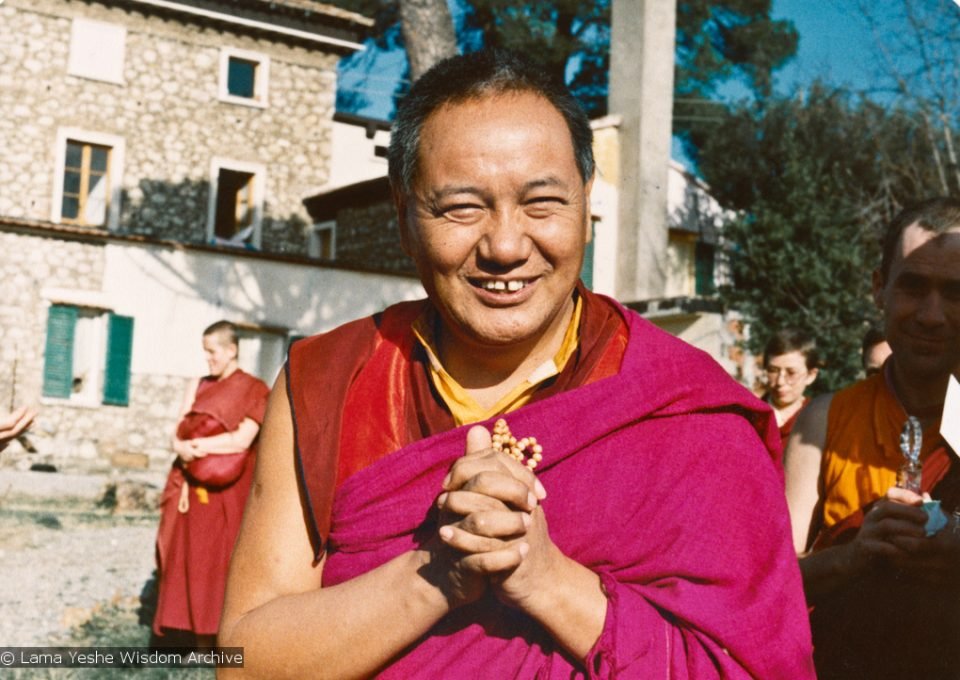
Lama Yeshe at Istituto Lama Tzong Khapa, Italy, 1983. Photo courtesy Lama Yeshe Wisdom Archive, donated by Merry Colony.
Lama Thubten Yeshe, who founded the FPMT organization with Lama Zopa Rinpoche, is fondly remembered for his ability to communicate the essence of Buddhist teachings in a way that continues to connect with Western students. In 1983, Lama Yeshe offered teachings on Gyalwa Gyatso, the highest yoga tantra aspect of Chenrezig, during a retreat at Istituto Lama Tzong Khapa in Italy. Here Lama Yeshe talks about the benefit of developing a profound practice of loving kindness wisdom energy:
Many young people today have lost their identity. They have difficulty understanding who they are, so they try to identify with different roles, different ideas. But then, not finding their identity in any of these roles, they become lost. Disturbed, they lead meaningless lives doing whatever comes to mind, without much thought. Such things are happening in this world.
From the moment we were born until now, each of us has tried to emanate in many different ways. Many of us have emanated as hippies and movie stars or as terrorists or politicians, capitalists, or communists. We have tried almost everything, only to discover in the end that whatever we have tried to identify with has turned out to be illusion, not reality.
These are good examples. You can see how your concrete concept of “me” tries to identify with some outer philosophical viewpoint, thinking, “I am this; I am this.” But then “this” is not what you find that you are. Instead, today you have discovered that you have loving kindness wisdom energy. You know you have this within you. You should trust this energy and identify with it instead of trusting outer projections. Your loving kindness wisdom energy must be cultivated, fertilized, protected, and tended well, like a garden. It can be nourished and developed and unified as the deity Gyalwa Gyatso.
We carry within us a heavy blanket of concepts and projections about ourselves. Over time we have constructed a kind of concentration camp within us, one iron bar, then another and another and another—so many concrete projections. In order to break through these projections, we need a profound vision of method and wisdom. We need to clothe ourselves in the very finest image: the union of great compassion and nonduality. This is your identity—your identity and your reality. You should wear this image in order to break through your limited, closed projections of who you are.
In our twentieth-century world there is so much hatred, disunity, and conflict. People are fighting for material possessions, are trying to conquer each other, never feeling love for one another. You can see this going on everywhere. It is incredible. Sometimes, even with a beloved friend, when you are both angry, you can’t feel your friend’s love and you can’t feel love for them. So we all understand how much the world needs peace and love—each individual and mankind as a whole. Therefore, we can easily see how logical and how worthwhile it is to practice such a profound yoga method. With this practice there is no need for hesitation; there can be no philosophical objections. It is very scientific, very down to earth.
When we talk about loving kindness, we are just using words. But mere words do not help. We may know the words, but if we don’t actively energize loving kindness in our nervous system, then we have achieved nothing. This yoga method unifies loving kindness with our nervous system. This is exactly what we need. … We should put concentrated effort and dedication into our retreat, then at least we will have been telling the truth when we promised, during the initiation, to engage seriously in this practice. And, of course, we will be doing something worthwhile.
Love and compassion come in different forms. There is pure love and pure compassion, which manifest in the form of Gyalwa Gyatso. But there is also selfish love. If we think about it, we can see that selfish love can be either positive or negative. It has both qualities. On the one hand, selfish love and selfish motivation are based on mental projections that fixate on their objects, such as family, husband, wife, or nationality, as “mine.” While the love you feel is, in fact, selfish, at the same time because of it, you give and share something. You give to your brother, your sister, your husband or wife thinking, “Because they are my relatives, because we Italian people are the same, because we all eat pizza, I therefore have an obligation to give them what I can.”
Selfish love, although limited, does have a kind of manipulative power to give, to serve. It has power that can aid in transforming you into a better, warmer person. For example, many men say, “Oh, I am not a bad man. I take care of twenty children and my wife. I send them to school, I give them good food, and I love them. They have a good home, and I do everything I can for them. Because of this, when I die, I shall die happy and satisfied.” There is some satisfaction in this. Do you understand? The motivation may be selfish and limited, but one’s actions bring benefit to others, and as a result a kind of transformation takes place.
Even though selfish love does have these positive attributes, it is clear that pure love and pure compassion serve in a much more profound, more dedicated way and bring about far more profound and far-reaching results. By practicing the profound highest yoga tantra method of Gyalwa Gyatso—the pure vision of the Dalai Lama—we are engaging in a mental exercise to eliminate the selfish mind completely. Through this profound practice of transformation, we can develop pure limitless love and compassion and thus experience directly their effectiveness in our own lives. We can experience this pure vision for ourselves. Because we so often see each other as objects of anger and hatred due to our mental projections, we are sorely in need of this pure vision. It is genuinely worthwhile and, happily, there is no doubt at all that we can achieve it.
Excerpted from Lama Yeshe’s teachings on the yoga method of Gyalwa Gyatso, given at Istituto Lama Tzong Khapa, Italy, in 1983. Edited by Constance Miller. Published in the Lama Yeshe Wisdom Archive E-letter, February 2016.
Through timely advice, news stories, and updates, FPMT.org and Mandala Publications share the wisdom culture inspired and guided by the teachings of FPMT founders Lama Thubten Yeshe and Lama Thubten Zopa Rinpoche.
22
Lamrim Year: Lama Yeshe on Impermanence and Death
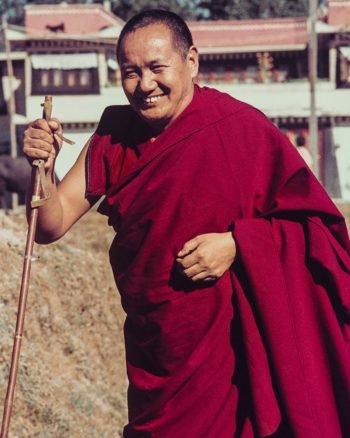
Lama Yeshe with his ski-pole, Ninth Meditation course, Kopan, 1976. Photo courtesy of Lama Yeshe Wisdom Archive.
Lamrim Year: Making Life Meaningful Day By Day is an essential guide for students at any level of Buddhist study who want to develop their mind in the graduated path to enlightenment (lamrim). The book was inspired by Lama Zopa Rinpoche’s advise to students on how they could study the entire lamrim over the course of a year.
This 365-day outline has a page for each day with a quote and text selected from four decades of teachings by FPMT founders Lama Yeshe and Lama Zopa Rinpoche. The page concludes with a recap summarizing the main points for reflection and a reference to the lamrim topics covered.
Here’s an excerpt featuring Lama Yeshe’s teachings:
Day 87: Impermanence and Death (Lama Yeshe)
From the moment we were born we’ve been destined for death
—Lama Yeshe
It’s important for Dharma students to understand Lord Buddha’s scientific teachings on impermanence and death and not try to hide from or escape the reality of death. We need to face it.
Of course, for people brought up the way they are these days, this topic might be a little bit too much, because in general nobody teaches us about this aspect of reality. When I talk about death we might think, “Oh, that’s Lama’s thing, not mine,” even though it’s an undeniable fact that illness and death are within us right now. How can we reject our own nature? How can we escape from death when we are living immersed in the conditions for it to arise right now?
That’s why I always say that Buddhism is not diplomatic in character. It shows us straight up our own nature. But that doesn’t mean we should cry emotionally, “No! That’s too bad. I’m going to get sick and die. Dying is terrible!” We mustn’t think in an ordinary way. Do we think that’s wisdom? “Don’t tell me that! I don’t like it!” That’s not wisdom. Check up carefully. Old people don’t like that they’re old so they just push back and deny it. Is that wisdom or not? From my point of view, from Buddhism’s point of view, that’s stupidity and ignorance. Rejecting how old we are; hiding from information about death. And we can’t say that teachings on death are simply an Eastern custom. Is our death an Eastern custom? Has our death been created by Lord Buddha? No. Our death has not been created by Eastern custom, by Lord Buddha or by Buddhism. It’s in our very nature, so how can we reject it?
- As Dharma students, it’s vital to face up to the reality of impermanence and death
- We can’t escape death when we are immersed in the conditions for it to arise right now
- Death is in our very nature, so it’s stupid and ignorant to become emotional or to deny it
Impermanence and death
For a printed copy of Lamrim Year: Making Life Meaningful Day By Day and links to more excerpts, visit the Lama Yeshe Wisdom Archive:
https://www.lamayeshe.com/shop/lamrim-year-book
You can find the ebook version of Lamrim Year: Making Life Meaningful Day By Day on the FPMT Foundation Store:
https://shop.fpmt.org/Lamrim-Year-Making-Life-Meaningful-Day-By-Day-eBook-_p_3438.html
For more resources on lamrim study, see the FPMT Education Services’ “Lamrim” page:
https://fpmt.org/education/prayers-and-practice-materials/lam-rim/
Through timely advice, news stories, and updates, FPMT.org and Mandala Publications share the wisdom culture inspired and guided by the teachings of FPMT founders Lama Thubten Yeshe and Lama Thubten Zopa Rinpoche.
- Tagged: advice from lama yeshe, impermanence and death, lama yeshe wisdom archive, lama yeshes wisdom, lamrim
3
Your Future Is in Your Hands
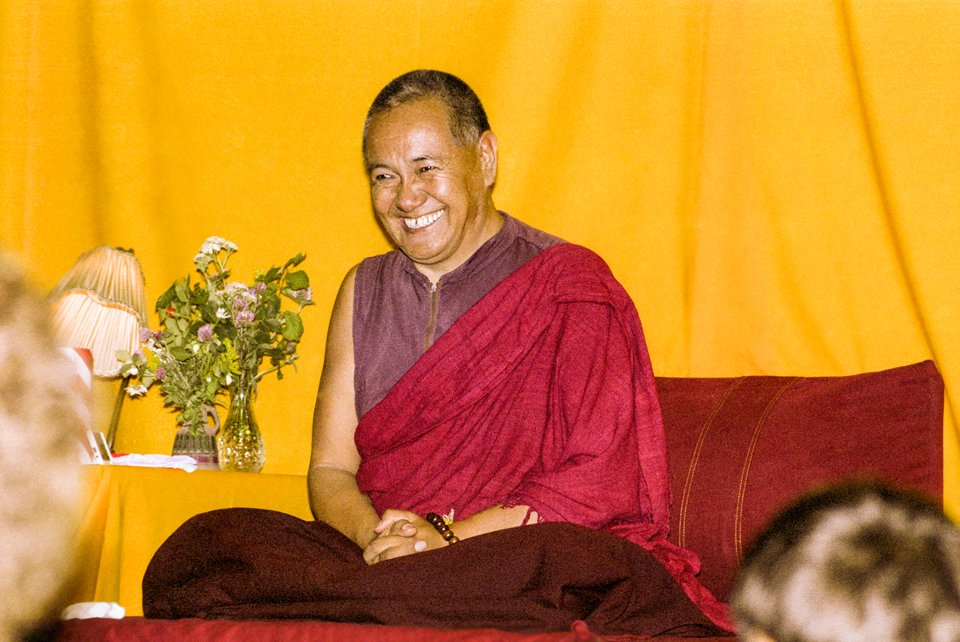
Lama Yeshe in Stockholm, Sweden, September 1983. Photo courtesy of Lama Yeshe Wisdom Archive.
Lama Thubten Yeshe, who founded the FPMT organization with Lama Zopa Rinpoche, is fondly remembered for his ability to communicate the essence of Buddhist teachings in a way that connected with Western students. In September 1983, Lama Yeshe gave a public talk in Sweden, where he discussed why we should not be afraid of death. In the following excerpt of the talk, Lama Yeshe explains what we can do now to improve this life and the next.
Whether you believe in reincarnation or not, you do know that you have a body and a mind. You also know that your mind is the main problem, not your nose. Since you understand that clean clear, it’s good to develop your understanding of the mind. This is very important for your life and for gaining the happiness you seek. And that’s what Buddhism talks about: human problems and how to deal with them and the fact that each of us is individually responsible for our own happiness and misery.
The way to liberate yourself from the uncontrolled mind is to put an end to your small, narrow, nonsensical way of thinking and to recognize that you can change it and think something else. It’s so natural. You don’t have to grasp at belief in God or Buddha; it’s just a humanistic thing. Even Western children know this. I once asked a young Italian boy what he did when he had problems. He said, “When I have problems I think about something else.” If you ask adults that question, they’ll have difficulty answering: “I wouldn’t know what to do.” I was very happy with the boy’s reply. It was such a natural answer. Adults would be like, “Oh, Lama, it’s so hard!”
OK, now, I don’t like problems myself, so maybe I should talk about good things. The good thing is, if you have a pure attitude, loving kindness for others, you’ll have no problems when you die. If you can recognize that any confusion you experience is just some kind of mental projection, you’ll have no fear. If you see that it’s just a trip and are able to deal with reality, there’s no way that your dying experience will be dangerous.
Many people, consciously or unconsciously, are scared of what comes after death. If your mind is clean clear, if you have loving kindness for others and no self-cherishing, concrete concepts, you have nothing to worry about. Your future lives will get better and better.
Of course, if at death your mind becomes a crazy chicken or a crazy pig, or a crazy snake, it’s possible that you’ll be reborn as a chicken, pig, or snake. Unfortunately. But that’s difficult for the Western mind. If you’re born a young boy or girl—intelligent, clean clear—but as you get older you take drugs and get drunk a lot, your mind can become worse than bananas. This is not something made up by Tibetans or Buddhists. It’s part of your culture. Don’t think, “I’m beautiful. How can I become an ugly pig?” You might have been a beautiful teenager, but in your old age, your good looks get completely destroyed. You can see that. It’s the same with the mind. It can degenerate in the same way and then finish up entering such an undesirable body. It’s very flexible.
Excerpted from “We Should Not Be Afraid of Death,” published in Mandala July–December 2015, which is taken from a public lecture given by Lama Yeshe at the Ethnographic Museum, Stockholm, Sweden, September 8, 1983. It was edited from the Lama Yeshe Wisdom Archive by Nicholas Ribush.
Through timely advice, news stories, and updates, FPMT.org and Mandala Publications share the wisdom culture inspired and guided by the teachings of FPMT founders Lama Thubten Yeshe and Lama Thubten Zopa Rinpoche.
19
Lama Yeshe’s Legacy: Taking a Broad View
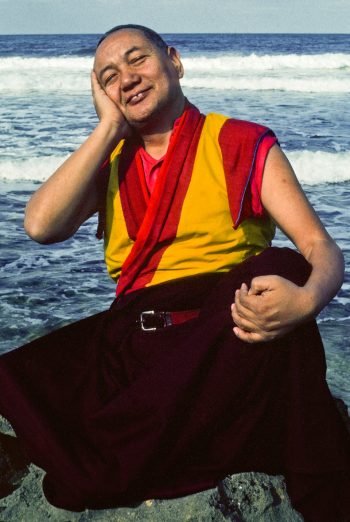
Lama Yeshe, Sicily, 1983. Photo by Jacie Keeley, courtesy of Lama Yeshe Wisdom Archive.
In 1983, more than 50 centers and projects constituted the international FPMT mandala. Representatives from those centers and projects gathered in January of that year at Istituto Lama Tzong Khapa in Italy to discuss the registration of FPMT as a charitable organization and the formulation of its bylaws. During the week-long meeting, Lama Thubten Yeshe, who founded the FPMT organization with Lama Zopa Rinpoche, gave an inspiring talk on the FPMT organization’s objectives, structure, and function. Here’s an excerpt from that talk:
Why have we established the FPMT? Why are we establishing these facilities all over the world? I think we are clean clear as to our aim—we want to lead all sentient beings to higher education. We are an organization that gives people the chance to receive higher education.
We offer people what we have—the combined knowledge of Buddha’s teachings and the modern way of life. Our purpose is to share our experience of this.
We know that people are dissatisfied with worldly life, with the education system and everything else. It is in the nature of our dualistic mind to be dissatisfied. So what we are trying to do is to help people discover their own totality and thus perfect satisfaction.
Now, the way we have evolved is not through you or me having said we want to do these things but through a natural process of development. Our organization has grown naturally, organically. It is not “Lama Yeshe wanted to do it.” I’ve never said that I want centers all over the world. Rather, I came into contact with students who then wanted to do something, who expressed the wish to share their experience with others, and put together groups in various countries to share and grow with others.
Personally, I think that’s fine. We should work for that. We are human beings; Buddhism helps us grow. Therefore, it is logical that we should work together to facilitate this kind of education. And it is not only we lamas who are working for this. The centers’ resident geshes and the students are working too. Actually, it is you students who are instrumental in creating the facilities for Dharma to exist in the Western world. True. Of course, teachers help, but the most important thing is for the students to be well educated. That is why we exist.
When we started establishing centers there was no overall plan—they just popped up randomly all over the world like mushrooms, because of the evolutionary process I’ve just mentioned and the cooperative conditions. Now that all these centers do exist, we have to facilitate their development in a constructive, clean clear way; otherwise everything will just get confused. We have to develop properly both internally and in accordance with our 20th-century environment. That’s why I’ve already put forward guidelines for how our centers should be—residential country communities, city centers, monasteries, and so forth. …
Now, the way to bring Dharma to the Western world is to bring the nuclear, essential aspect of Dharma. Of course, you cannot separate the essence from the Eastern cultural trappings immediately: “This is culture; that isn’t.” However, what you should do is take the practical points of Dharma and shape them according to your own culture. In my opinion, you should be making a new kind of Dharma dependent on each different place and its social customs. Since we are Mahayanists, we have a broad view and don’t mind if Dharma takes different shapes. To bring Dharma to the West, we should have a broad view. …
Our aim is clear; it is to educate people. Each center should have strong emphasis on education. The education system and program are essential for us to be successful. Why are we building communities? Because we have no home? No! We are not refugees; we have not started centers to house refugees. Thus it is important for each center to have a strong educational program and a spiritual director to conduct it. This is an essential part of our structure and must be there.
But I am not going to keep telling you things that you know already. Still, it is important that I clarify the reason for our existence and what we are doing. It is important work; we are not joking. We are real. Also, we are confident. I have great confidence in my involvement with Western people; I believe in it. I think that there are things that we can understand in common. We understand each other; therefore, we can work together.
Also, it is important for directors to have a great vision; they should not neglect their center’s growth. They should have a very broad view in order to be open to people. In many of our centers we find that already the facilities are too small. Of course, to build adequate facilities takes time and energy; but we should have a broad open view: “We would like to have things this way, without limitations.” Having a broad view is not forcing any issue but simply saying that if we have the opportunity to do various things, we’ll do them. You never know when somebody might come up to you and say, “I’d like to do something beneficial with my money.” At that time you can reply, “Well we have this project ready to develop,” and show that person your plans. If, however, you feel suffocated with what you already have and don’t have any vision of how to expand, you can’t show potential benefactors anything. Therefore, you should plan ahead with great vision and have everything ready to show people how you want to expand and improve your facilities. … Remember—to bring Dharma to the West, we have to have a broad view.
Read more in “Lama Yeshe’s Legacy: Taking a Broad View.” From Lama Yeshe’s address to the Council for the Preservation of the Mahayana Tradition (CPMT) meeting at Istituto Lama Tzong Khapa, Italy, January 1983. Edited by Nicholas Ribush and excerpted in Mandala January-March 2015. You can read the entire talk “Lama Yeshe’s Address to the FPMT Family” on the Lama Yeshe Wisdom Archive website (lamayeshe.com).
Through timely advice, news stories, and updates, FPMT.org and Mandala Publications share the wisdom culture inspired and guided by the teachings of FPMT founders Lama Thubten Yeshe and Lama Thubten Zopa Rinpoche.
- Tagged: advice from lama yeshe, cpmt, fpmt history, lama yeshes wisdom
6
Different People Need Different Methods
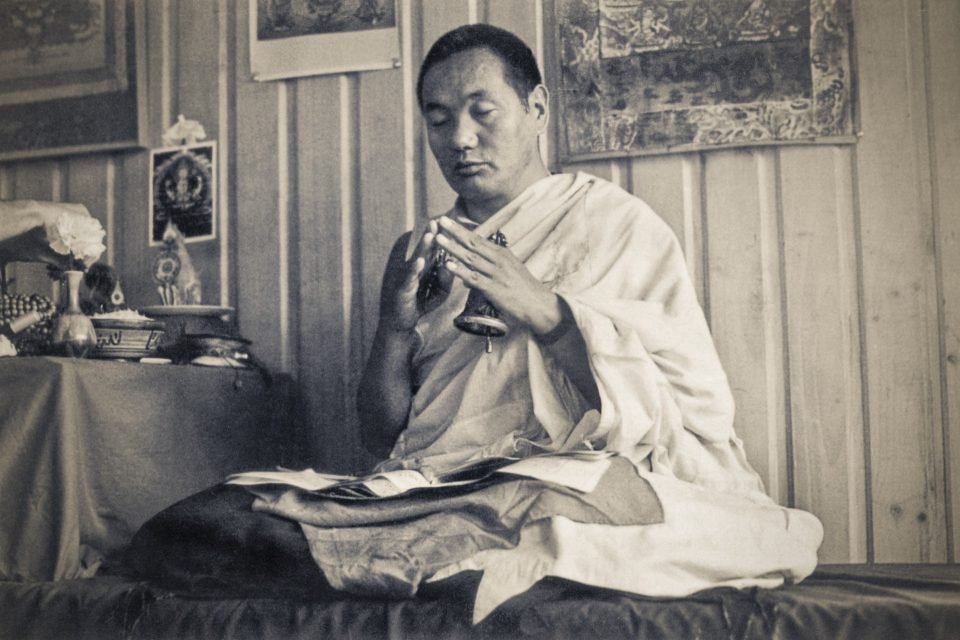
Lama Yeshe, Waikanae, New Zealand, 1975. Photo by Ecie Hursthouse, courtesy of Lama Yeshe Wisdom Archive.
Lama Thubten Yeshe, who founded the FPMT organization with Lama Zopa Rinpoche, excelled at helping Western students connect with the essence of the Buddha’s teachings. Here Lama Yeshe offers advice on how to understand the different schools and traditions of Buddhism.
The characteristic nature of all of Lord Buddha’s teachings and methods is psychology and knowledge wisdom. And what he taught was not just theoretical but practical and based on experience.
In general, theories and ideas are inadequate if they lack the key of understanding. We need to know how to put them into practice. Because of this, the Tibetan tradition has always emphasized the importance of passing the experiential lineage, not just the theories, from guru to disciple, and in this way the living teachings of the Buddha have come down to us today.
There are four different schools of Tibetan Buddhism, but their similarities are far greater than their differences. They all contain the complete methods for reaching enlightenment, from beginning to end, and all practice tantric yoga, the Vajrayana. But while they all have the same methods, some emphasize certain meditation techniques over others. That’s the main difference. But they’re all equally Mahayana and all practice both Paramitayana and Vajrayana.
While the Hinayana, the Southern school of Buddhism, contains neither the practices of the Paramitayana nor those of the Vajrayana, it in no way contradicts the Northern, or Mahayana, schools. Lord Buddha sometimes said “yes” and sometimes said “no.”
We can understand what he meant by looking at how a skilled physician treats a patient. When somebody is sick, the treatment can vary during the course of the illness. For example, at first the doctor may recommend fasting, but later, as the person recovers, the doctor may recommend meat and other heavy foods. When that happens you don’t get angry with the doctor for contradicting himself: “First you said ‘no,’ now you’re saying ‘yes’! Don’t you know what you’re doing?” No—rather you think how kind and wise he is.
It’s the same thing with Lord Buddha’s teachings. Different people need different methods. For example, I’m a monk. I took my vows on the basis of my own decision. Strictly interpreted, according to the vinaya rules, I’m not supposed to stare at women’s faces. I can look at men but not at women.
The Mahayana view qualifies this. For monks, just looking at women isn’t the problem; it’s looking at them with an attached, grasping mind, with craving, emotional desire. That’s what disturbs you. You can’t say that just looking automatically means you’re sick. It depends on your mind.
Similarly, Lord Buddha never said that monks can’t touch women, just like that. He never proscribed any actions without explaining why and under what conditions. Lord Buddha’s vinaya psychology is incredible. He explained in minute detail with what kind of mind, what kind of attitude, you should avoid doing this or that. He never, ever said, “You can’t do that because I said so.”
There’s a profound psychology behind all his teachings.
So, monks cannot touch women with craving desire, and nuns can’t touch men with craving desire. Doing so makes you lose conscious awareness. That’s the danger. If you have the power to stop your finger from burning, you can stick it into a fire. But if you don’t, and your finger will burn, why stick it into a fire? That’s all Lord Buddha is saying. Anyway, whether or not something will burn when it’s put into a fire depends on what kind of material it is. It’s not automatic that whatever’s put into a fire will burn.
So you can see that there’s no contradiction between the Hinayana and Mahayana schools of Buddhism. And with respect to the four Tibetan schools, there’s no such thing as “this one takes this kind of precept, that one takes a different kind.” All four schools take the same precepts.
Also, it’s not necessary that everybody who wants to practice Buddhism takes ordination as a monk or nun. The Mahayana offers people many different ways of practicing Dharma. In particular, the Mahayana does not emphasize external signs of practice; those are not important. What matters is mental attitude. On the other hand, the Hinayana, or Theravada, school does emphasize physical actions—how you act and so forth. Some of their rules are very strict and definitely needed. But none of this is contradictory.
Excerpted from a seminar given by Lama Thubten Yeshe in Christchurch, New Zealand, June 14, 1975. Courtesy of Lama Yeshe Wisdom Archive. Edited by Nicholas Ribush. Published as “Different People Need Different Methods” in Mandala July-September 2012.
Through timely advice, news stories, and updates, FPMT.org and Mandala Publications share the wisdom culture inspired and guided by the teachings of FPMT founders Lama Thubten Yeshe and Lama Thubten Zopa Rinpoche.
16
Lama Yeshe on the Experience of Death
Lama Thubten Yeshe, who founded the FPMT organization with Lama Zopa Rinpoche, is remembered for his ability to communicate the essence of Buddhist teachings in a way that connected with Western students. In September 1983, Lama Yeshe gave a public talk in Stockholm, Sweden, where he discussed why we should not be afraid of death. In the following excerpt from the talk, Lama Yeshe explains what happens at the time of death.
First, we should not be afraid of death because from the moment we were born we’ve been destined to die. There’s no way out. Sometimes people get angry when they’re asked how old they are: “That’s none of your business!” But even though getting old is natural, it often makes Western people upset.
Dying, too, is natural and, as we know, it can be a gradual experience. It can also be a blissful experience, although most people regard it as something fearsome. That’s a wrong attitude. Our body is composed of the four elements of earth, water, fire, and air, and in the course of a natural death, these four elements gradually disintegrate. We also have five skandhas, or aggregates—form, feeling, discrimination, compositional factors, and consciousness. At the time of death, these too sequentially deteriorate, or lose power.
What first happens when we die is that the form skandha, the essence of our body, begins to disintegrate and we feel as if we are being buried under a great pile of dirt. The concomitant dissolution of our earth element causes us great confusion, as do the forthcoming dissolutions of the other skandhas and elements.
Therefore, it is very important to educate people and ourselves as to what happens during the death process so that we know what’s coming and can understand that it’s just a mental projection. In that way, we can die without fear and confusion. In this first cycle our eye sense also dissolves and our eyesight becomes unclear. The internal sign is a mirage-like vision.
Next, the skandha of feeling disintegrates, and we lose all sense of pain and pleasure. We also lose our hearing. Our body becomes just like a dead banana! Along with this our water element dissolves. The internal sign is an appearance of smoke.
Third, our fire element and skandha of discrimination disintegrate, and we can no longer remember the names of our mother, father, husband, wife, children, or other family and friends. We also lose our sense of smell. Our inhalation becomes weak and our exhalation lengthy. The internal sign is that of sparks of fire. These internal signs are not observed by our eye sense consciousness but are mental projections, manifestations of our more subtle consciousness and akin to dreaming.
So you can see, during the death process, as in life actually, nobody is creating problems for you other than yourself. All your anxiety, emotional hatred, desire, and so forth come from within yourself. At this time, however, your delusions naturally slow down and gradually disappear.
In the fourth cycle our air element deteriorates, and our breathing stops altogether. At this point all our ego problems naturally disappear. This is not as a result of practice; it’s just natural. It is here that meditators take the opportunity of meditating on the fundamental nature of universal reality. By contemplating on it more and more they can begin to gain direct experiences of it.
I want to make one thing very clear here because Western preconceptions are very strong regarding this—from the Buddhist point of view, even though external breathing seems to have stopped and it would appear to be the moment of clinical death, a subtle breath remains inside. The person is not yet completely dead. This explanation conflicts with baby Western science. Western science is very young, and its opinion on this is very dangerous because, at this stage of the death process, the person is still alive and can survive for a long time in the subtle body with subtle breathing, which is not observable from the outside.
As you know, India is a very hot place and refrigerators for corpses are few and far between. So they tend to burn bodies within hours of what they consider to be death. I heard that once someone was being burned and when his body was half burned he sat up and cried, “Please don’t burn me, I’m not dead!” This is human experience. I’m not talking religion here. Don’t think that this is some Buddhist projection. Ordinary people saw this.
Similarly, I heard of a case in France where a nonreligious man was declared dead by doctors but awoke after a couple of hours. He wrote a quite well known book describing his experience of being dead for two hours. Again, this is human experience, not something influenced by Buddhist or religious philosophy.
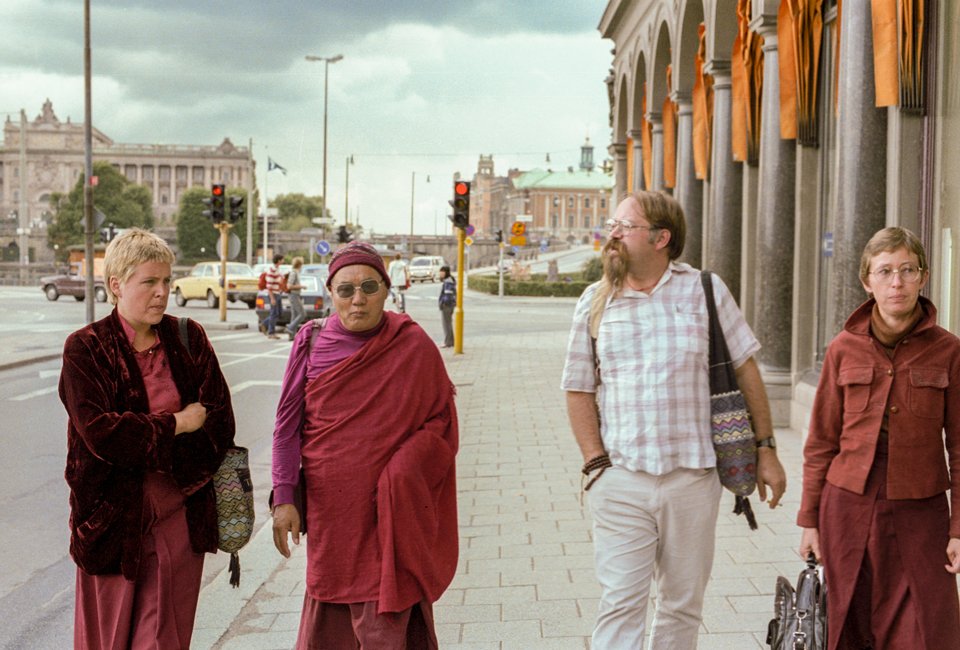
Lama Yeshe with (from left) Ven. Gun Johansson, Jeff Nye, and Ven. Karin Valham, Stockholm, Sweden, September 1983
Completing the Death Process
After our breathing stops we experience three visions. The first of these is the white vision. This has nothing to do with our physical eye sense, which is already a dead banana. It’s an inner, mental experience. Because all our crowded, intellectual, ego-grasping superstitions have stopped, we suddenly reach a point of infinite space, or sky. The impression in our mind is of a calm, clear blue sky, a clear mental experience of completely infinite blue space that appears to our subtle consciousness as a white light vision.
From that experience our mind again moves to infinite blue sky in which there now appears a red light vibration. Then that suddenly stops and everything goes black. Finally, this black vision slowly clears and we again experience infinite universal space and a fourth vision, that of clean clear light. In this there are no concepts, no value judgments, no classifications, and no division of anything into good and bad.
Some meditators can remain in the clear light meditation for many days. Even if you are not a meditator, you stay there a little while. Even if you don’t believe you’re in a clean clear state, you stay in the clear light state of consciousness anyway. Sometimes we refer to it as the dharmakaya experience. Actually there’s a bit of a debate about this. Some meditators say that everybody experiences universal reality. Others say that it’s not exactly that but similar.
The Intermediate State
When the clear light vision stops, our consciousness finally separates from our body and passes into the intermediate state, the bardo. Because the clear light was so bright, when it stops, passage into the bardo is experienced as darkness. Then we’re in the bardo for a while and when it’s time to go into the next life, we go through the three visions in reverse: the dark vision, the red vision, and the white vision. After that, in our next life, all our worldly superstitions and ego problems arise once more.
What is a bardo being? The bardo body is not material like ours. It’s a sort of conscious body. It’s very light and can pass through mountains and other solid things. Its only enjoyment is smell. It has no desire to eat chocolate. But it is full of confusion and superstition and is constantly seeking to come into the desire realm, grasping to enter a mother’s womb.
A bardo being fortunate enough to be reborn human sees its future parents engaged in intercourse and its consciousness enters the father’s central channel, passes down through it and enters the products of conception in the mother’s womb. After that its development is exactly the same as contemporary science explains. Therefore, Western parents should not expect their children’s minds to be the same as their complicated minds. The new generation also has its own generation gap, its own evolution, and its own ignorant understandings. From the Buddhist point of view, every human being is completely different until we reach beyond the dualistic mind. Then everybody’s mind is at the same level.
What I’ve been describing here is the evolution of a natural human death. This is Buddhism’s scientific explanation of what happens to the human body and mind at death.
Excerpted from “We Should Not Be Afraid of Death,” published in Mandala July–December 2015, which is taken from a public lecture given by Lama Yeshe at the Ethnographic Museum, Stockholm, Sweden, September 8, 1983. It was edited from the Lama Yeshe Wisdom Archive by Nicholas Ribush.
Find more advice and resources on death and dying at FPMT.org/death.
Through timely advice, news stories, and updates, FPMT.org and Mandala Publications share the wisdom culture inspired and guided by the teachings of FPMT founders Lama Thubten Yeshe and Lama Thubten Zopa Rinpoche.
- Tagged: advice for death and dying, advice from lama yeshe, death, death and dying, impermanence and death, lama yeshes wisdom
24
You Cannot Say All Desire Is Negative
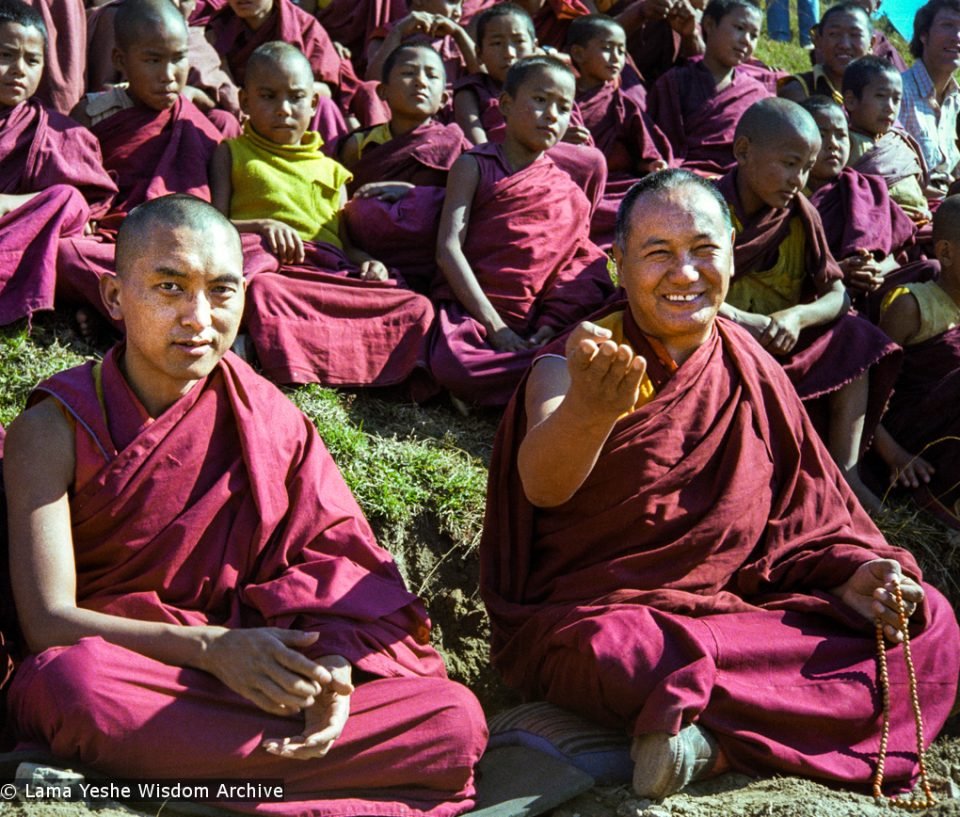
Lama Zopa Rinpoche and Lama Yeshe at the twelfth Meditation Course, Kopan Monastery, Nepal, 1979. Photo by Ina Van Delden, courtesy of Lama Yeshe Wisdom Archive.
Lama Thubten Yeshe, who founded the FPMT organization with Lama Zopa Rinpoche, excelled at helping Western students connect with the essence of the Buddha’s teachings. He encouraged students to use their judgement and showed them how to be serious, yet balanced Dharma practitioners. Here Lama Yeshe offers advice on how to view attachment.
There are teachings in the lamrim that say we should be grateful for the eight worldly dharmas. Why is that? First of all, how can we gain liberation from samsara without transcending the eight worldly dharmas? Even Shakyamuni Buddha himself went through them on his way to enlightenment. It’s part of our spiritual evolution. At some point, having gone through the eight worldly dharmas, we reach beyond them, attaining liberation or even enlightenment.
In his lamrim teachings, Lama Tsongkhapa very clearly describes three types of eight worldly dharmas: black, mixed, and white. When we engage in worldly activity, one aspect of our action might be good, but as we’re doing it a negative thought can arise so that the result will be sort of mixed. So philosophically, and this is also in the lamrim, you can’t say that all attachment is negative. Westerners can be oversensitive. They see in the lamrim that attachment is our biggest problem and conclude that it must be completely negative. Lama Tsongkhapa says, “No!”
Logically we can see that, from the Buddhist point of view, all human life, including our body, comes from the positive mind. It’s positive karma that produces this body that gives us the ability to enjoy things. But, as human beings, we have limitations. When the lamrim teachings highlight certain aspects of our life as negative, we can jump to the conclusion that everything to do with attachment is negative: “I am completely negative; the world is completely negative.” Then everything gets very dark, because that’s the exaggerated way in which we project or interpret it.
I want you to understand clean clear that we distinguish two things: negative, or sinful, and positive. Attachment, or desire, can be negative and sinful, but it can also be positive. The positive aspect is that which produces pleasure: samsaric pleasure, human pleasure—the ability to enjoy the world, to see it as beautiful, to have whatever you find attractive.
So you cannot say that all desire is negative and produces only pain. Wrong. You should not think like that. Desire can produce pleasure—but only temporary pleasure. That’s the distinction. It’s temporary pleasure. And we don’t say that temporal pleasure is always bad, that you should reject it. If you reject temporal pleasure, then what’s left? You haven’t attained eternal happiness yet, so all that’s left is misery.
But you should not make the mistake of trying to actualize temporary pleasure [as an end in itself]. You can enjoy it while you have it, but you should not squeeze yourself striving for it. The problem is the mind that believes temporary pleasure to be the best there is. That’s a total delusion, an over-estimated conception. Like looking at a cloud in the sky and thinking, “What a beautiful cloud; I wish it would last forever.” You’re dreaming.
We should recognize all our human pleasures as similarly impermanent. They come; they go. They’re limited, and we should expect them to be limited. That’s their nature. Our expectations should always be in accord with the way things are. Therefore, we should not grasp at temporary pleasure as if it were eternal, everlasting happiness. That’s deluded, a fantasy.
Of course, the lamrim and Mahayana Buddhism in general talk about attachment and self-cherishing as incredibly big problems. And when you hear that, you might think, “I want to give them up today!” You can’t. It’s impossible; you’re too ambitious. You need to understand that attachment is a problem in everyday life because you have too many fixed ideas and unreasonable expectations. You can’t give all that up overnight. Work it out slowly: “I’m grateful to understand how attachment works, but it will take time to overcome it. There are certain things I can handle now, but I can’t manage everything at once.”
Remember what I said about the mixed eight worldly dharmas—actions that are a little bit white and a little bit black so that the results are mixed too; not totally negative. So you have to see where you fall in this and use your own judgment when deciding how to deal with your own attachment. Just don’t look at all attachment as completely negative. It’s not. There are degrees of attachment.
You’ve probably heard about the five paths and the ten bodhisattva levels (bhumis). For example, there are the paths of merit, preparation and seeing, at which point one attains the first bhumi. It’s quite a long journey. From there up to the eighth bhumi, you can still have some attachment. As I said, it has degrees.
Knowing this, we beginners should be encouraged that it is only when we reach the incredibly high eighth bodhisattva bhumi that we are completely free of attachment. Starting from where we are, we first deal with its gross levels and slowly, slowly rid ourselves of it.
So don’t be too idealistic: “How fantastic. Lama has told me all about attachment”; and then go home and tell your father, “Your problem is attachment”; your boyfriend, “Your problem is attachment.” Everything is attachment. Then people start telling you, “You know what? Your problem is attachment.”
Well, philosophically, we might understand attachment clean clear, but in practice we have to be reasonable and, as the lamrim explains, have a realistic attitude towards attachment. So, if you see some benefit for yourself or others in doing something, even small, although it might be tinged by attachment, do it. Do what you can; that’s good enough.
When some Westerners first encounter the lamrim teachings they get the impression that it’s all about suffering: “Buddhism says I’ve been suffering since forever! I should be suffering!” Since they’ve been brought up to believe that in fact they should not suffer and should always enjoy pleasure, they really don’t like this Eastern way of thinking and can’t reconcile the two. Have you felt like that? Anyway, it’s not true. Buddhism wants you and all other sentient beings to discover everlasting happiness and bliss; eternal peace. That’s the enlightenment experience; that’s the goal of the lamrim teachings. Don’t think that small worldly pleasures are the only happiness there is; that if you just have this thing or that, you’ll be happy. That’s small, narrow-minded thinking. And that’s the problem.
Worldly happiness is OK, but judge it reasonably. Enjoy it without grasping at it as real, which only results in more pain. That’s all that Buddhism is talking about. You should have pleasure and not feel guilty when you do. What do I mean by pleasure? It’s a feeling that satisfies you for a moment and doesn’t disturb your mind. You get a little pleasure—that’s good enough. Accept it for what it is and don’t feel guilty. Be as happy as possible. If you’re irritated, how can you be peaceful within yourself or give happiness to those around you?
If I’m crying my eyes out and at the same time saying, “I want to give you happiness, I want to give you happiness,” you’re not going to know how to handle me. “He wants to give me happiness but he’s crying.” Soon you’re going to start crying too. All we do is make each other cry.
Therefore, if you’re experiencing pleasure, be reasonable; remain calm and clear, even if you notice that your grasping mind is there beneath it all. And if you have a feeling of loving kindness towards another, enjoy that too. Don’t feel guilty.
Lama Yeshe gave this teaching during the twelfth Kopan meditation course, November 1979. Edited from the Lama Yeshe Wisdom Archive (www.lamayeshe.com) by Nicholas Ribush. Published as “You Cannot Say All Desire Is Negative” in Mandala January-March 2014.
For more on the eight worldly dharmas, see Lama Zopa Rinpoche’s How to Practice Dharma: Teachings on the Eight Worldly Dharmas.
Through timely advice, news stories, and updates, FPMT.org and Mandala Publications share the wisdom culture inspired and guided by the teachings of FPMT founders Lama Thubten Yeshe and Lama Thubten Zopa Rinpoche.
1
Taking Suffering and Giving Happiness
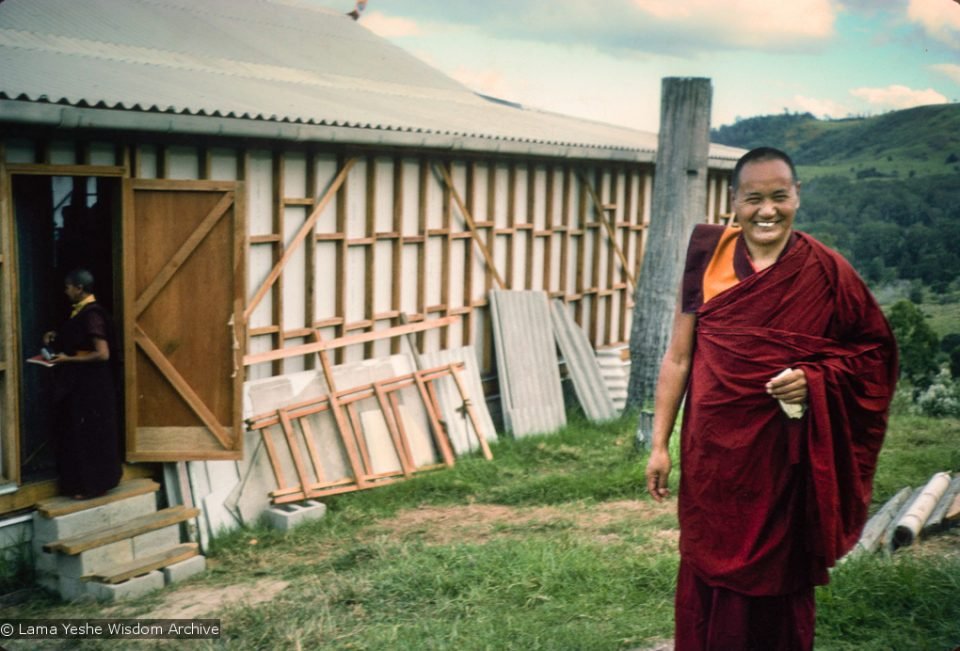
Lama Yeshe during the month-long course at Chenrezig Institute, Australia, 1975. Photo courtesy of Lama Yeshe Wisdom Archive.
Lama Thubten Yeshe, who founded the FPMT organization with Lama Zopa Rinpoche, had a way of clearly relating Dharma practice to the everyday experiences of the Western students he taught. Here Lama Yeshe offers advice on how to understand attachment and transform it into compassionate concern for others.
We are most fortunate to have been able to pinpoint attachment as the greatest of all problems. When we speak of evil, demons, and so forth, it’s the inner devil of attachment we’re talking about. Even though for countless lives we’ve looked outside ourselves for the source of our problems, there’s nothing external to blame. Therefore we should rejoice that we have finally identified this inner cause of all suffering.
We can be quite foolish. Say you’re in a spooky old house somewhere with a couple of friends. It’s late at night, and you’re watching horror movies on TV. One of your friends says, “Don’t go into the basement; there’s something evil down there.” Then, if you do have to go down to the basement, you feel scared: “There really is something evil down here.” You’re so easily prone to superstition. This is completely silly. There’s no such thing as external evil and fear of it is simply a projection of the evil in your own mind. If you speculate enough, your superstitious mind is sure to produce something, and where once you were unafraid, you now feel fear. All such foolishness comes from attachment.
Therefore finally recognizing that all these negative things—demons, enemies, evil, or whatever other terms are used in everyday conversation, science, or religion—come from the inner demon of attachment and bravely changing attachment to oneself into concern for others is both wonderful and wise.
There are countless living beings on Earth but very few know about exchanging self and others. This practice may be very difficult but it’s extremely worthwhile. If you can do it, it will help solve all your problems.
Changing your outlook in this way transforms whatever misery you perceive into the peaceful path of liberation.
We desperately need a method such as this. Life is suffering; our minds are weak. Exchanging self and others is truly revolutionary and this inner revolution, which has nothing to do with radical external change, completely turns our mental attitude upside down.
If you were to think that Buddhism was simply about sitting in meditation practicing concentration, you might reject it: “My knees hurt; my body wasn’t built for this. Buddhism is just a Himalayan lama thing. Anyway, I can’t live without working and taking care of my worldly affairs. Dharma is not for me.” But Mahayana Buddhism is about much more than just sitting in concentration. If you are wise, you can practice twenty-four hours a day.
Whenever any difficulty or problem arises, instead of getting depressed, be brave. Think, “Fantastic. If this problem had not arisen I might have felt I had no problems. This problem is my teacher; all problems are my teacher. They give me knowledge-wisdom and help me recognize more clearly the nature of attachment. This is so wonderful. May all mother sentient beings’ problems ripen upon me right now and may they receive all my merit, fortune, and wisdom.”
If you have difficulty taking the suffering of others onto yourself, first practice on yourself. The next time your knees hurt when you’re sitting in meditation, take that pain onto your ego and let it freak out. Let your ego freak out more and more. Practice that for a week.
Then practice taking onto yourself all the suffering you have ever experienced in your life. Your ego and attachment won’t like that either, but let them freak out again. Then slowly, slowly extend your practice to take upon yourself the sufferings of your parents, your friends, all the people in your country, and all the people on Earth until you are receiving the problems and suffering of all sentient beings throughout the universe. Then, without hesitation, send out to them all your possessions, happiness, and merit.
What is the technique for actually practicing this taking and giving meditation, which Tibetans call tonglen? You combine it with meditation on the breath in what is basically a nine-round breathing meditation.
Start by breathing out through your right nostril. Visualize the air you exhale in the form of white light, the essence of which is all your positive energy and wisdom. This white light radiates to all sentient beings in the six realms of samsara and beyond. It enters their left nostril, goes into their hearts and generates in them great bliss. Visualize the air they exhale in the form of thick black smoke, the essence of which is all their negativity, confusion, and heavy suffering. This dark, polluted energy enters your left nostril and goes down into your heart. Don’t leave it outside of you; bring it right down into your heart so that your ego and attachment completely freak out.
The nature of attachment is such that when problems arise, it blindly pushes them away. This practice trains your mind to handle negativity, feel compassion for the others, and take their suffering and problems onto yourself, which in turn helps you overcome self-cherishing and cherish others more than yourself.
Do the above cycle of breathing white light out through your right nostril and black smoke in through your left three times. Then breathe out through your left nostril and in through your right three times. Then breathe out and in through both nostrils together three times. At the end of each nine rounds concentrate for as long as you can that you and all other sentient beings have been completely purified of all suffering, negativity, and dualistic mind, and are fully enlightened, experiencing everlasting bliss that pervades your entire body and mind. When you lose focus on this, repeat the nine rounds once more. Repeat this cycle again and again for the duration of the session.
Don’t think that this is just a fantasy and that doing this meditation makes no difference to the suffering of yourself and others. Actually, it is a profound practice, and each time you do it, it brings you and all other sentient beings closer to enlightenment. The greatest obstacle to enlightenment is self-cherishing, and taking on all the suffering, karma, and delusions of all sentient beings and giving them all your happiness and merit is the best way of overcoming it. The most effective way of training your mind to overcome self-cherishing is to practice tonglen meditation.
From Mandala eZine February 2011. Originally published in Ego, Attachment and Liberation, a free publication from the Lama Yeshe Wisdom Archive (LamaYeshe.com). The book features a collection of Lama Yeshe’s teaching from a five-day meditation course near Melbourne, Australia in 1975.
Through timely advice, news stories, and updates, FPMT.org and Mandala Publications share the wisdom culture inspired and guided by the teachings of FPMT founders Lama Thubten Yeshe and Lama Thubten Zopa Rinpoche.
27
Questions and Answers on How We Exist in the World
Lama Yeshe, who founded FPMT with Lama Zopa Rinpoche, had a remarkable ability to connect with Western students. What follows are questions and answers from a teaching Lama Yeshe gave in July 1976 to Australian students on how we exist in the world. In these teaching, Lama Yeshe also spoke on karma and willpower:
Question: It seems that Buddhism revolves around shunyata. Could you please explain what that is, what absolute nature is?
Lama Yeshe: Modern science has discovered that all matter—different colors, different objects and so forth—may appear differently, but there is some essential energy, some quality, that embraces all existent matter equally. Buddhism says the same thing. There is an absolute reality, shunyata, that equally embraces all existence. But our relative mind, our mundane thought, cannot see this. It is obscured by superstition.
Therefore, when you meditate or contemplate on your mind, your consciousness, as your concentration deepens this relative perception vanishes. You can release all superstition and relative appearances and experience universal reality. Is that clear? It’s a difficult thing, but the human problem is not understanding the reality of what we are.
Q: Is it possible to discover absolute nature without a guru?
Lama: Sure. It’s possible. When we talk about a guru we’re not saying you need one in this life. Some people are born having already discovered absolute nature. Therefore you can’t say you need a guru to discover it. Even among us here, some people are quite advanced, others have a long way to go. So you cannot say “that-this” exactly. It depends how developed your intelligence is.
Actually, we talk about both relative guru and absolute guru. The relative guru is the person who shows you the path and puts your mind into the right channel. The absolute guru is your own wisdom. Therefore, the absolute guru is more important than the relative.
Q: Lama, do you feel a sense of “I,” and if so, could you explain its nature?
Lama: Do you mean do I feel I have an “I”? [Yes.] Of course I have an “I”—a big “I”! Yes, for sure!
But that’s a good question. I have a big “I,” but you have to be careful. Whether we’re a buddha or a sentient being, we all, equally, have a relative “I.” But we sentient beings paint our relative I over and over again, layer upon layer, coat upon coat. Although deep within, the I is completely nothing, Layer upon layer, we build up a huge, hallucinated world, “This is me.” Then, when somebody says to us, “You are bad,” we get terribly hurt. Actually, nobody can make us bad, nobody can make us good. Our goodness or badness is our own experience. But the intellect is too much, too much. That’s the way it is.
You may read the complete teaching in the Lama Yeshe Wisdom Archive’s July 2020 E-letter. Lama Yeshe gave this teaching in Olinda, Victoria, Australia, 30 July 1976. Archive #776. Edited by Nicholas Ribush. See Big Love: The Life and Teachings of Lama Yeshe, Volume 1, Chapter 15, “Melbourne: The Olinda Course” for the context of this teaching.
Through timely advice, news stories, and updates, FPMT.org and Mandala Publications share the wisdom culture inspired and guided by the teachings of FPMT founders Lama Thubten Yeshe and Lama Thubten Zopa Rinpoche.
- Home
- News/Media
- Study & Practice
- About FPMT Education Services
- Latest News
- Programs
- New to Buddhism?
- Buddhist Mind Science: Activating Your Potential
- Heart Advice for Death and Dying
- Discovering Buddhism
- Living in the Path
- Exploring Buddhism
- FPMT Basic Program
- FPMT Masters Program
- FPMT In-Depth Meditation Training
- Maitripa College
- Lotsawa Rinchen Zangpo Translator Program
- Universal Education for Compassion & Wisdom
- Online Learning Center
- Prayers & Practice Materials
- Overview of Prayers & Practices
- Full Catalogue of Prayers & Practice Materials
- Explore Popular Topics
- Benefiting Animals
- Chenrezig Resources
- Death & Dying Resources
- Lama Chopa (Guru Puja)
- Lama Zopa Rinpoche: Compendium of Precious Instructions
- Lama Zopa Rinpoche: Life Practice Advice
- Lama Zopa Rinpoche Practice Series
- Lamrim Resources
- Mantras
- Prayer Book Updates
- Purification Practices
- Sutras
- Thought Transformation (Lojong)
- Audio Materials
- Dharma Dates – Tibetan Calendar
- Translation Services
- Publishing Services
- Teachings and Advice
- Find Teachings and Advice
- Lama Zopa Rinpoche Advice Page
- Lama Zopa Rinpoche: Compendium of Precious Instructions
- Lama Zopa Rinpoche Video Teachings
- ༧སྐྱབས་རྗེ་བཟོད་པ་རིན་པོ་ཆེ་མཆོག་ནས་སྩལ་བའི་བཀའ་སློབ་བརྙན་འཕྲིན།
- Podcasts
- Lama Yeshe Wisdom Archive
- Buddhism FAQ
- Dharma for Young People
- Resources on Holy Objects
- Ways to Offer Support
- Centers
- Affiliates Area
- Teachers
- Projects
- Charitable Projects
- Make a Donation
- Applying for Grants
- News about Projects
- Other Projects within FPMT
- Support International Office
- Projects Photo Galleries
- Give Where Most Needed
- FPMT
- Shop
Translate*
*powered by Google TranslateTranslation of pages on fpmt.org is performed by Google Translate, a third party service which FPMT has no control over. The service provides automated computer translations that are only an approximation of the websites' original content. The translations should not be considered exact and only used as a rough guide.If twenty-four hours a day, everything you do is motivated by bodhichitta, you accumulate infinite merit. Moreover, every single action becomes a cause not only for your own enlightenment, but also the happiness of every other sentient being.
